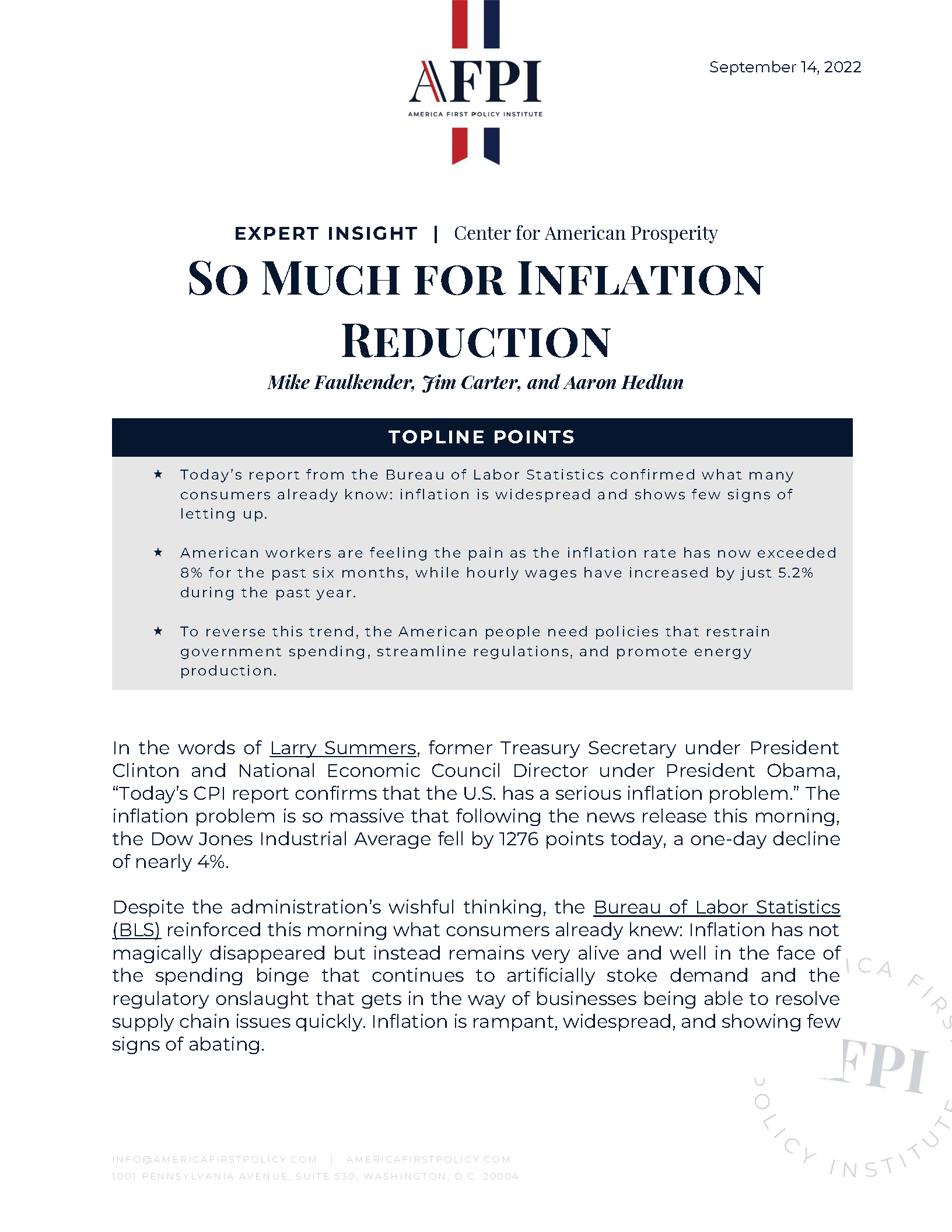So Much for Inflation Reduction
Key Takeaways
Today’s report from the Bureau of Labor Statistics confirmed what many consumers already know: inflation is widespread and shows few signs of letting up.
American workers are feeling the pain as the inflation rate has now exceeded 8% for the past six months, while hourly wages have increased by just 5.2% during the past year.
To reverse this trend, the American people need policies that restrain government spending, streamline regulations, and promote energy production.
In the words of Larry Summers, former Treasury Secretary under President Clinton and National Economic Council Director under President Obama, “Today’s CPI report confirms that the U.S. has a serious inflation problem.” The inflation problem is so massive that following the news release this morning, the Dow Jones Industrial Average fell by 1276 points today, a one-day decline of nearly 4%.
Despite the administration’s wishful thinking, the Bureau of Labor Statistics (BLS) reinforced this morning what consumers already knew: Inflation has not magically disappeared but instead remains very alive and well in the face of the spending binge that continues to artificially stoke demand and the regulatory onslaught that gets in the way of businesses being able to resolve supply chain issues quickly. Inflation is rampant, widespread, and showing few signs of abating.
For the sixth consecutive month, inflation exceeded 8% in August, which has become the new normal under the Biden Administration. Despite a more than 10% decline in gas prices between July and August, a pullback to still-high levels for which the Biden Administration cannot credibly claim credit, nearly every other category of spending saw price increases. Overall, prices rose 0.1% for the month and 8.3% for the last 12 months. As shown in the figure below, these inflation rates hadn’t otherwise been seen since the inflation surge of the late 1970s and early 1980s.
Most punishing has been the double-digit food inflation that continues to pummel consumers. Average food prices rose 0.8% in just the last month, with overall food inflation for the last 12 months registering at 11.4%, which is “the largest 12-month increase since the period ending May 1979,” according to BLS. Lower-income households are particularly hard hit by rising food prices. For the average American household, between eating at home and dining out, BLS estimates that approximately 14% of consumer spending is on food. According to the Department of Agriculture, food spending represents a staggeringly higher 27% of income for the lowest income quintile of households.
Excluding food and energy, core inflation showed a 6.3% increase in prices over the last 12 months, just below March’s 40-year high of 6.4%. One glance at the figure on core CPI below clearly shows that inflation is far from being slain.
The price of new vehicles rose 0.8% for the month and more than 10% over the last year. Household furnishings are likewise up 9.9% over the last 12 months. The largest component of consumer spending is on housing, and the cost of shelter increased 0.7% during the month for a 12-month increase of 6.2%. Compare any of these to the Federal Reserve’s 2% inflation target in 12 months, and the failure of the Biden Administration’s appointees is apparent.
Unfortunately for the American worker, wages have not kept up. While prices have increased 8.3% in the last 12 months, hourly wages have gone up just 5.2%. This corresponds to a 2.9% drop in inflation-adjusted wages over the last 12 months. Since President Biden assumed office, wages adjusted for inflation have fallen more than 4.1%.
Despite the White House’s ongoing blame game, deflection, and big government socialism bill (dishonestly framed as inflation reduction), inflation is near its 40-year record high and widespread across all spending categories. After its $2 trillion stimulus bill kicked off the inflation surge in spring 2021, the administration has followed up on it with more spending at every opportunity it could seize. The ironically named “Inflation Reduction Act” is, in essence, a special interest stimulus bill retread with more of the same big government spending and higher taxes that have contributed to inflation. Most recently, the student loan bailout announced by the Biden Administration represents a regressive, inflationary redistribution of wealth from blue-collar workers to the higher-income credentialed class that sets the stage for future loan bailouts down the road. In other words, a new federal entitlement gives students every incentive to overborrow and colleges to overcharge.
Today’s data release underscores the urgency that the federal government must change its policy direction. The American people need policies that restrain government spending, streamline regulations, encourage work, and promote energy production. Only then can we confidently expect a return to the low-inflation, broad-based prosperity of the pre-pandemic years.
